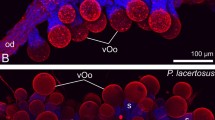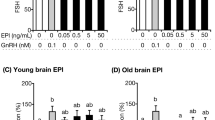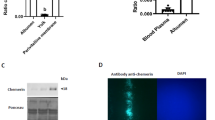Abstract
PROLONGED feeding of rats with ethionine results in a high frequency of hepatic carcinoma. Ethionine induces other pathological manifestations in other organs and tissues of experimental animals1, and some of its effects can be reversed rapidly by the administration of methionine. At the molecular level ethionine induces a rapid decrease in hepatic ATP concentration2–4, followed by inhibition of RNA5 and protein synthesis6. The decrease in ATP concentration is due to formation of S-adenosyl-ethionine7, an inhibitor of tRNA methyltransferases8,9, and so tRNA isolated from the liver of rats injected with adenine and ethionine is hypomethylated10,11. It is well established that several eukaryotic mRNAs are methylated on the 5′ terminus and that such modification is essential for translation12,13. To study the mechanism of methylation we attempted to produce a specific methyl-deficient mRNA by the administration of ethionine. To monitor the effectiveness of the deprivation of methyl groups the synthesis of hormone-induced ovalbumin in immature chick oviducts was followed. Administration of oestrogen to immature chicks causes cytodifferentiation and growth of the primitive oviduct14–17. The tubular gland cells synthesise ovalbumin, conalbumin, ovomucoid and lysozyme which comprise 85–90% of the egg-white proteins18. The continuous presence of oestrogen is required for sustained synthesis of these proteins in immature chicks; withdrawal of oestrogen is accompanied by a gradual decline in cell-specific protein synthesis as well as in the weight of the oviduct and the RNA content of the tissue17. But, the tubular gland cells in the oviduct magnum during withdrawal are retained although they do not synthesise cell-specific secretory proteins17,19. Readministration of hormone to chicks after withdrawal (secondary stimulation) results in restoration of cell-specific protein synthesis without concomitant need for DNA synthesis17. During these studies ethionine unexpectedly simulated the effects of the injection of oestrogen for secondary stimulation.
This is a preview of subscription content, access via your institution
Access options
Subscribe to this journal
Receive 51 print issues and online access
$199.00 per year
only $3.90 per issue
Buy this article
- Purchase on Springer Link
- Instant access to full article PDF
Prices may be subject to local taxes which are calculated during checkout
Similar content being viewed by others
References
Farber, E., Adv. Cancer Res., 7, 383–474 (1963).
Farber, E., Shull, K. H., Villa-Trevino, S., Lombardi, B., and Thomas, M., Nature, 203, 34–40 (1964).
Shull, K. H., J. biol. Chem., 237, 1734–1735 (1962).
Villa-Trevino, S., Shull, K. H., and Farber, E., J. biol. Chem., 238, 1757–1763 (1962).
Villa-Trevino, S., Shull, K. H., and Farber, E., J. biol. Chem., 241, 4670–4674 (1966).
Farber, E., and Corban, M. S., J. biol. Chem., 233, 625–630 (1958).
Shull, K. H., McConomy, J., Vogt, M., Castillo, A., and Farber, E., J. biol. Chem., 241, 5060–5070 (1966).
Moore, B. G., and Smith, R. C., Can. J. Biochem., 47, 561–565 (1969).
Moore, B. G., Can. J. Biochem., 48, 702–705 (1970).
Rajalakshmi, S., Proc. Am. Ass. Cancer Res., 14, 39 Abstr. (1973).
Kerr, S. J., Cancer Res., 35, 2969–2973 (1975).
Rottman, F., Shatkin, A. J., and Perry, R. P., Cell, 3, 197–199 (1974).
Muthukrishnan, S., Both, G. W., Furuichi, Y., and Shatkin, A. J., Nature, 255, 33–37 (1975).
O'Malley, B. W., McGuire, W. L., Kohler, P. O., and Korenman, S. G., Rec. Prog. Hormone Res., 25, 105–160 (1969).
Kohler, P. O., Grimley, P. M., and O'Malley, B. W., J. Cell Biol., 40, 8–26 (1969)
Oka, T., and Schimke, R. T., J. Cell Biol., 41, 816–823 (1969).
Oka, T., and Schimke, R. T., J. Cell Biol., 43, 123–137 (1969).
Palmiter, R. D., J. biol. Chem., 247, 6450–6461 (1972).
Palmiter, R. D., Christensen, A. K., and Schimke, R. T., J. biol. Chem., 245, 833–845 (1970).
Palmiter, R. D., Oka, T., and Schimke, R. T., J. biol. Chem., 246, 724–737 (1971).
Sharma, O. K., Mays, L. L., and Borek, E., J. biol. Chem., 248, 7622–7624 (1973).
Sharma, O. K., Mays, L. L., and Borek, E., Biochemistry, 14, 509–514 (1975).
Rhoads, R. E., McKnight, G. S., and Schimke, R. T., J. biol. Chem., 246, 7407–7410 (1971).
Sharma, O. K., Roberts, W. K., Beezley, D., and Borek, E., Biochim. biophys. Acta, 390, 327–331 (1975).
Locke, M., and Krishman, J. Cell Biol., 50, 550–553 (1971).
Reynolds, E. S., J. Cell Biol., 17, 208–212 (1963).
Aitken, R. N. C., and Johnston, H. S., J. Anat., 97, 87–89 (1963).
Hendler, R. W., J. biophys. biochem. Cytol., 3, 325–330 (1957).
Author information
Authors and Affiliations
Rights and permissions
About this article
Cite this article
SHARMA, O., BOREK, E. & MARTINEZ-HERNANDEZ, A. Induction of ovalbumin and conalbumin synthesis in immature chick oviducts by ethionine. Nature 259, 588–591 (1976). https://doi.org/10.1038/259588a0
Received:
Accepted:
Issue Date:
DOI: https://doi.org/10.1038/259588a0
This article is cited by
-
The carcinogen ethionine elevates progesterone levels
Nature (1977)
Comments
By submitting a comment you agree to abide by our Terms and Community Guidelines. If you find something abusive or that does not comply with our terms or guidelines please flag it as inappropriate.



